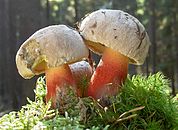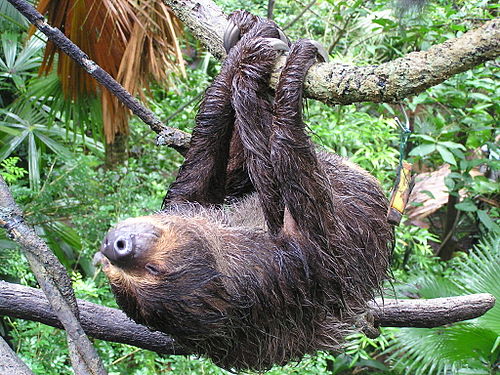Main Page
|
Welcome to The free species directory that anyone can edit. It covers Animalia, Plantae, Fungi, Bacteria, Archaea, Protista and all other forms of life. So far we have 495,508 articles Wikispecies is free, because life is in the public domain! You can also check us out on Twitter: @Wikispecies, |
Taxon Navigation
|
 |
 |
 |
 |
 |
 |
 |
| Haloquadratum walsbyi | Sitta europaea caesia | Boletus calopus | ♂Aphyocharax anisitsi | ♀Brachypelma smithi | Hippopotamus amphibius | Euphorbia leuconeura |
Explore Wikispecies
Collaboration with ZooKeys A collaboration between Wikispecies and ZooKeys has been announced. PhytoKeys also joined the collaboration in November 2010. Images of species from ZooKeys and PhytoKeys will be uploaded to Wikimedia Commons and used in Wikispecies.
Distinguished authorMary Agnes Chase Mary Agnes Chase, née Merrill, was an American botanist who worked at the U.S. Department of Agriculture and the Smithsonian Institution. She is considered one of the world's outstanding agrostologists and is known for her work on the study of grasses, and also for her work as a suffragist. Chase was born in Iroquois County, Illinois and held no formal education beyond grammar school. That aside, she made significant contributions to the field of botany, authored over 70 scientific publications, and was conferred with an honorary doctorate in science from the University of Illinois. She specialized in the study of grasses and conducted extensive field work in North- as well as and South America. Her Smithsonian Field Books collection from 1897 to 1959 is archived in the Smithsonian Institution Archives. In 1901, Chase became a botanical assistant at the Field Museum of Natural History under Charles Frederick Millspaugh, where her work was featured in two museum publications: Plantae Utowanae (1900) and Plantae Yucatanae (1904). Two years later, Chase joined the U.S. Department of Agriculture (USDA) as a botanical illustrator and eventually became a scientific assistant in systematic agrostology (1907), assistant botanist (1923), and associate botanist (1925), all under Albert Spear Hitchcock. Chase worked with Hitchcock for almost twenty years, collaborating closely and also publishing, for instance The North American Species of Panicum (1910). Following Hitchcock's death in 1936, Chase succeeded him to become senior botanist in charge of systematic agrostology and custodian of the Section of Grasses, Division of Plants at the United States National Museum (USNM). Chase retired from the USDA in 1939, but continued her work as custodian of the USNM grass herbarium until her death in 1963. She was an Honorary Fellow of the Smithsonian Institution (1959) and Fellow of the Linnean Society of London (1961). Agnesia is named in her honour (a monotypic genus of herbaceous South American bamboo in the grass family). Chase experienced discrimination based on her gender in the scientific field, for example, being excluded from expeditions to Panama in 1911 and 1912 because the expedition's benefactors feared the presence of women researchers would distract men. During World War I, Chase marched with Alice Paul and was jailed several times for her activities. In 1918, she was arrested at the Silent Sentinels rally picketing the White House; she refused bail and was held for 10 days, where she instigated a hunger-strike and was force-fed. The USDA accused her of "conduct unbecoming a government employee," but Hitchcock helped her keep her job. Chase was also an active member of the National Association for the Advancement of Colored People (NAACP). See also: Distinguished authors of previous months. |
Species of the monthHoffmann's Two-toed SlothSome facts on this mammal: Length: 58 to 70 cm. Weight: 4 to 8 kg. Distribution: South America. Hebitat: Tropical rainforest canopy from sea level to 3,300 metres. Diet: Mainly tree leaves; may also eat fruits and flowers. Protection status: Least Concern (IUCN 3.1). First described: By the German zoologist and explorer. Wilhelm Peters in 1858. Choloepus hoffmanni isn't the best candidate to win a running race. In fact this Two-toed Sloth has the record for the world's slowest mammal. So sedentary it is, that algae grows on its furry coat. The slots come in two variants: the two-toed and three-toed, identified by the number of long, prominent claws that they have on each front foot. These animals are built for life in the treetops, spending nearly all of their time aloft, hanging from branches with a powerful grip of their long claws. Choloepus hoffmanni also sleep in trees, and they do this in abundance: between 15 and 20 hours every day. Even when awake they often remain motionless. At night they eat leaves, shoots, and fruit from the trees and get almost all of their water from juicy plants. Sloths mate and give birth while hanging in the trees and their young cling to their mothers and travel by hanging onto them for the first five weeks of their lives. The name of this animal commemorates the German physician and naturalist Karl Hoffmann. See also: Species of previous months |
Wikispecies in other languagesالعربية · ئۇيغۇرچە · Alemannisch · Aragonés · অসমীয়া · Asturianu · Azərbaycanca · Bahasa Indonesia · Bahasa Melayu · بلوچی · Български · বাংলা · Беларуская · Boarisch · Bosanski · Brezhoneg · Català · Čeština · Cymraeg · Dansk · Deutsch · Eesti · Ελληνικά · English · Ænglisc · Español · Esperanto · Euskara · فارسی · Føroyskt · Français · Galego · ქართული · 廣東話 · 한국어 · Հայերեն · Hrvatski · Interlingua · Íslenska · Italiano · עברית · हिन्दी · қазақша · Кыргызча · Magyar · Македонски · मराठी · молдовеняскэ · Nederlands · नेपाली 日本語 · Nordfriisk · Norsk bokmål · Нохчийн · ଓଡ଼ିଆ · Occitan · Polski · Português · Ripoarisch/Kölsch · Română · Runa Simi · Русский · Shqip · සිංහල · Sicilianu · Simple English · Slovenčina · Slovenščina · Српски/Srpski · Sunda · Suomi · Svenska · Tagalog · தமிழ் · ไทย · Tiếng Việt · Türkçe · Українська · Veneto · Volapük · ייִדיש · Zazaki · 简体中文 · 正體中文 |
|
Wikispecies is run by the non-profit Wikimedia Foundation, which operates several other multilingual and free-content projects:
|

